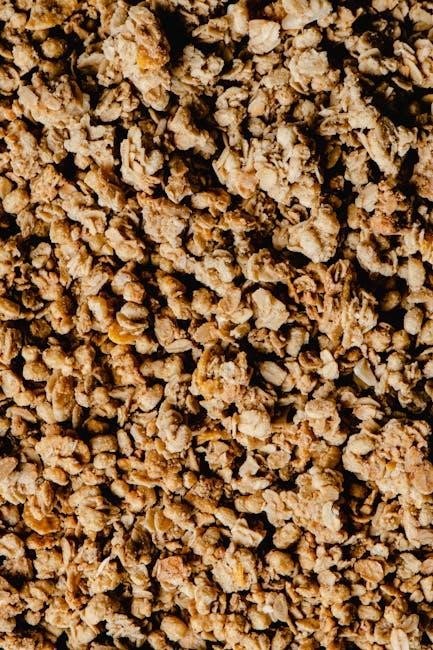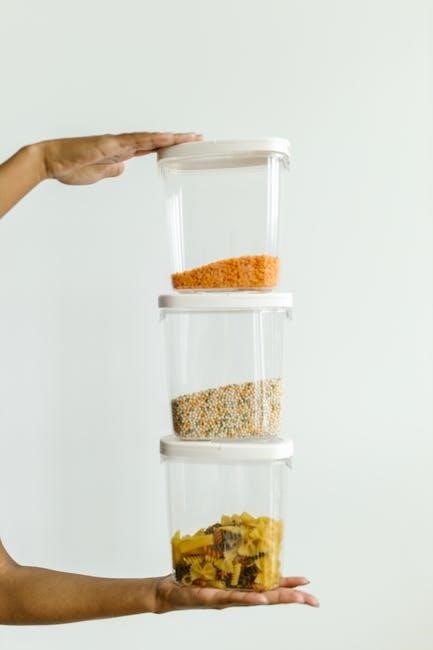Lean bulking is a strategic approach to gaining muscle without excess fat. It involves clean eating, calculated calorie intake, and balanced macronutrients to support growth while staying lean.
1.1 What is Lean Bulking?
Lean bulking focuses on gaining muscle mass while minimizing fat accumulation. It involves consuming a calorie-surplus diet with balanced macronutrients, emphasizing clean, nutrient-dense foods to support muscle growth without excess weight gain. This approach prioritizes sustainability and health, ensuring progressive muscle development over time.
1.2 Benefits of a Lean Bulk Meal Plan
A lean bulk meal plan offers controlled fat gain, ensuring muscle growth without excessive weight. It enhances nutrient efficiency, supports long-term health, and maintains a balanced diet. This approach is customizable, making it sustainable and effective for achieving muscle goals while preserving overall well-being.
Understanding Caloric Needs for Lean Bulking
Calculating caloric needs is crucial for lean bulking. It involves determining BMR, TDEE, and adding a surplus while balancing intake to avoid excess fat gain, tailoring to individual goals.
2.1 How to Calculate Your Basal Metabolic Rate (BMR)
Calculating BMR involves using the Mifflin-St Jeor formula: BMR (men) = 10w + 6.25h ౼ 5a + 5 and BMR (women) = 10w + 6.25h ౼ 5a ౼ 161, where w is weight in kg, h is height in cm, and a is age in years. This formula provides an accurate estimate for adults, which is then multiplied by an activity factor to determine TDEE, helping set calorie goals for lean bulking.
2.2 Determining Maintenance Calories (TDEE)
TDEE (Total Daily Energy Expenditure) is your daily calorie burn, including all activities. Calculate it by multiplying your BMR by an activity factor: 1.2 (sedentary), 1.375 (lightly active), 1.55 (moderately active), 1.725 (very active), or 1.9 (super active). This baseline helps set your lean bulking calorie goals without overeating.
2.3 Adding Calories for Lean Bulk
Add 250-500 calories above your TDEE to support lean muscle growth. This surplus ensures you’re fueling muscle development without excess fat gain. Adjust based on progress, aiming for 0.5-1 lb of weight gain weekly for a clean bulk.
Macronutrient Ratios for Lean Muscle Gain
Aim for a balanced macronutrient split: 25-30% protein for muscle repair, 40-50% carbs for energy, and 25-30% fats for hormone health. This ratio supports lean muscle growth effectively.
3.1 Protein Intake for Muscle Growth
Adequate protein intake is crucial for muscle synthesis. Aim for 1.2-2.2 grams per kilogram of body weight daily, spread across meals. High-quality proteins like chicken, fish, and whey promote lean muscle growth without excess fat, ensuring optimal recovery and hypertrophy.
3.2 Carbohydrate Intake for Energy
Carbohydrates are essential for energy and muscle recovery. Focus on complex, clean sources like oats, rice, and vegetables. Aim for 2-3 grams per kilogram of body weight daily, balancing intake around workouts to fuel performance and support lean muscle growth without excess fat storage.
3.3 Healthy Fat Intake for Hormone Health
Healthy fats are crucial for hormone production and overall health. Include sources like avocados, nuts, and olive oil, aiming for 0.5-1 gram per kilogram of body weight daily. These fats support testosterone levels and aid in muscle recovery, ensuring a balanced and sustainable lean bulking diet.
Sample 7-Day Lean Bulk Meal Plan
This 7-day meal plan provides a structured approach to lean bulking, with 5 balanced meals daily. It includes high-protein, complex carbs, and healthy fats, ensuring optimal muscle growth while minimizing fat gain, using clean and nutrient-dense foods.
4.1 Breakfast Ideas
- Scrambled eggs with spinach, mushrooms, and whole-grain toast for sustained protein and fiber.
- Greek yogurt parfait with mixed berries, granola, and a drizzle of honey for natural sugars and protein.
- Oatmeal with peanut butter, banana slices, and a sprinkle of chia seeds for complex carbs and healthy fats.
- Protein smoothie with whey protein, spinach, almond milk, and a scoop of almond butter for a quick, nutrient-packed start.
4.2 Lunch Options
- Grilled chicken breast with quinoa, steamed broccoli, and a side of avocado for healthy fats and protein.
- Turkey and avocado wrap with whole-grain tortilla, mixed greens, and a light dressing for balanced macros.
- Salmon salad with mixed greens, cherry tomatoes, cucumber, and olive oil vinaigrette for omega-3 richness.
- Chicken stir-fry with brown rice, bell peppers, and soy sauce for a carb and protein-packed meal.
4.3 Dinner Recipes
- Grilled chicken breast with roasted sweet potatoes, asparagus, and olive oil for a balanced, high-protein meal.
- Baked salmon with quinoa, steamed green beans, and a lemon-dill sauce for omega-3 rich dinner.
- Turkey meatballs with whole-grain pasta, marinara sauce, and sautéed spinach for lean muscle growth.
- Lean beef stir-fry with brown rice, bell peppers, and soy sauce for a carb and protein-packed dinner.
4.4 Snack Recommendations
- Greek yogurt with berries and honey for a protein-packed snack.
- Hard-boiled eggs or a handful of mixed nuts for quick energy.
- Apple slices with peanut butter for balanced carbs and protein.
- A protein smoothie with whey protein, spinach, and almond milk.
- Turkey jerky or cottage cheese for convenient, high-protein options.
- Banana with almond butter for healthy fats and sustained energy.
Food Choices for a Lean Bulk Diet
Focus on nutrient-dense foods like lean proteins, whole grains, and healthy fats. Include chicken, fish, eggs, oats, sweet potatoes, and avocados to support muscle growth and overall health.
5.1 Best Protein Sources
Opt for lean animal proteins like chicken breast, fish, and eggs. Plant-based options include beans, lentils, tofu, and edamame. These provide essential amino acids for muscle repair and growth without excess fat.
5.2 Clean Carbohydrate Options
Focus on complex carbs like oats, brown rice, quinoa, and sweet potatoes. Incorporate vegetables such as broccoli, spinach, and bell peppers, as well as whole-grain bread and pasta for sustained energy and fiber, promoting muscle recovery and overall health.
5.3 Healthy Fat Sources
Healthy fats are essential for hormone production and sustained energy. Include sources like avocados, nuts, seeds, olive oil, and fatty fish in your diet. These fats support muscle growth and overall health, making them a crucial part of a lean bulking meal plan.

Supplements to Support Lean Bulking
Supplements like whey protein, creatine, and BCAAs can enhance muscle growth and recovery. They help meet nutrient needs and optimize performance during a lean bulking phase.
6.1 Whey Protein Powder
Whey protein is an essential supplement for lean bulking, providing high-quality protein for muscle recovery and growth. It’s low in fat and calories, making it ideal for maintaining a lean physique while meeting daily protein needs. Convenient for post-workout recovery or as a quick snack, whey protein supports muscle synthesis without excess fat gain.
6.2 Creatine for Muscle Growth
Creatine is a proven supplement that enhances strength and endurance, supporting muscle growth. It increases energy production during workouts, allowing for more intense training. Safe and effective, creatine promotes lean muscle gain without fat accumulation. Typically taken in 3-5 gram doses daily, it’s a popular choice for those seeking natural performance enhancement.
6.3 Other Beneficial Supplements
Beyond whey protein and creatine, supplements like HMB and BCAA can enhance muscle recovery and growth. HMB supports muscle repair, while BCAA promotes recovery and reduces muscle soreness. These additions complement a lean bulk diet, aiding in muscle preservation and growth without unnecessary fat gain, optimizing overall progress.

Tracking Progress and Adjustments
Regularly monitor weight, body fat, and measurements. Adjust caloric intake and macronutrient ratios as needed to ensure steady muscle growth without excess fat gain.
7.1 Monitoring Weight and Body Fat
Track weight weekly and body fat percentage every two weeks. Use a scale and calipers for accuracy. Adjust calorie intake based on progress to ensure muscle gain while minimizing fat accumulation. Regularly review measurements and progress photos to assess changes and make necessary dietary or training adjustments for optimal results.
7.2 Adjusting Caloric Intake
Monitor progress weekly and adjust caloric intake to maintain a lean bulk. Increase calories by 50-100 if muscle gain stalls, or reduce by 50-100 if fat accumulation exceeds goals. Aim for a caloric surplus of 250-500 calories above maintenance for steady growth. Adjust macros proportionally to maintain balance in your meal plan.
7.4 Fine-Tuning Macronutrients
Adjust macronutrient ratios based on progress. Increase protein intake to maintain muscle mass. Tweak carbohydrate intake to balance energy levels and fat gain. Optimize healthy fats for hormone health. Monitor and refine portions to ensure macronutrient balance aligns with muscle growth and fat control goals. Adjustments should be gradual and data-driven.
Common Mistakes to Avoid
Overeating leads to excess fat gain, while undereating can result in muscle loss. Poor food quality choices hinder progress. Avoid these pitfalls for effective lean bulking.
8.1 Overeating and Excess Fat Gain
Overeating can lead to excessive fat gain, undermining lean bulking goals. Consuming too many calories, especially from unhealthy sources, disrupts the balance needed for muscle growth. Tracking intake and focusing on nutrient-dense foods is crucial to avoid this common mistake and maintain a lean physique.
8.2 Undereating and Muscle Loss
Undereating can hinder muscle growth and lead to muscle loss. Insufficient calories deprive muscles of the energy needed for growth and recovery. Aiming for a slight surplus while maintaining balanced macronutrients is essential to support lean muscle gain without sacrificing hard-earned progress.
8.3 Poor Food Quality Choices
Poor food quality choices can hinder lean bulking progress. Consuming high-sugar, processed, or empty-calorie foods may lead to fat gain and reduce nutrient density; Prioritizing whole, nutrient-dense foods ensures optimal muscle growth and minimizes unwanted fat accumulation, aligning with the goals of a clean and effective lean bulk meal plan.

Sample Calorie Ranges for Lean Bulking
Sample calorie ranges for lean bulking typically vary from 2,000 to 4,500 calories daily, depending on individual needs, activity levels, and muscle-building goals.
9.1 2000-Calorie Meal Plan
A 2000-calorie meal plan is ideal for lean bulking at lower activity levels. It includes balanced macronutrients: 47g protein, 60g carbs, and 12g fat per meal, spread across 5 meals daily, ensuring muscle growth while minimizing fat gain.
9.2 3000-Calorie Meal Plan
A 3000-calorie meal plan supports lean bulking for active individuals or those with higher energy needs. It includes five balanced meals totaling 3000 calories, with macronutrient splits optimized for muscle growth and minimal fat gain, ensuring sustained energy and recovery.
9.3 4500-Calorie Meal Plan
A 4500-calorie meal plan is designed for individuals with very high energy needs, such as those engaging in intense training or with fast metabolisms. It provides ample calories for muscle growth while maintaining a balance of protein, carbs, and fats to support recovery and lean gains.

Customizing Your Lean Bulk Meal Plan
Customizing your lean bulk meal plan involves tailoring macronutrient ratios, food choices, and portion sizes to meet your specific needs, preferences, and goals for sustainable muscle growth.
10.1 Adjusting for Individual Needs
Adjusting for individual needs involves personalizing your lean bulk meal plan based on factors like age, weight, activity level, and dietary preferences. This ensures the plan aligns with your unique goals, promoting optimal muscle growth and minimizing fat gain. Tailoring the plan helps maintain consistency and maximizes results effectively.
10.2 Incorporating Personal Preferences
Incorporating personal preferences into your lean bulk meal plan ensures sustainability and enjoyment. Choose foods you like within macronutrient goals, such as swapping chicken for fish or adjusting carb sources; This flexibility keeps meals satisfying while maintaining nutritional balance for muscle growth and minimal fat gain.
Consistency and patience are key to lean bulking. Balance diet with training, stay disciplined, and you’ll achieve a strong, lean, muscular physique over time.
11.1 Staying Consistent and Patient
Consistency is crucial for lean bulking. Stick to your meal plan and training regimen daily, even when progress seems slow. Patience is key, as muscle growth takes time. Celebrate small victories and stay committed to your goals for long-term success.
11.2 Balancing Diet and Training
Balancing diet and training is essential for lean bulking. Tailor your meal plan to match workout intensity, ensuring proper fueling and recovery. Timing meals around training sessions optimizes performance and muscle growth. Consistency in both nutrition and exercise yields the best results for a lean, strong physique.